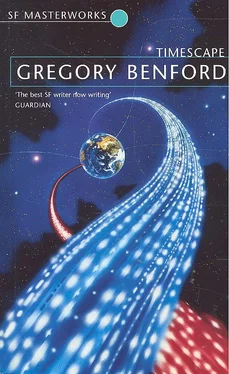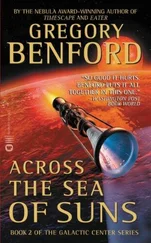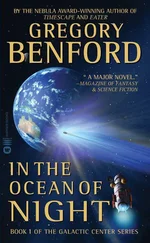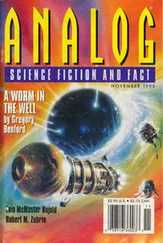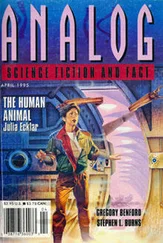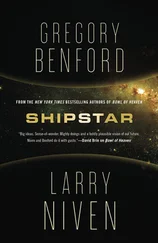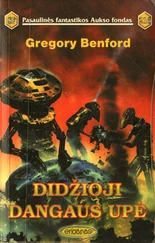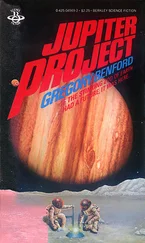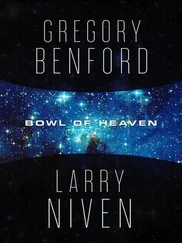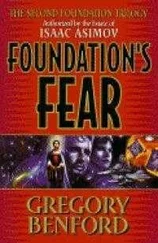On the other hand, Einstein’s theory was logically more elegant than Newton’s. Subtle, but simple. Its consequences were much harder to work out, which was the right way round. Markham scratched his beard absently. If you kept that in mind, you could discard many approaches before you began, knowing they would ultimately fail. There was no choice between beauty and truth, really. You had to wind up with both. In art, elegance was a whore of a word, bent a different way by each generation of critics. In physics, though, there was some fragile lesson to be learned from past millennia. Theories were more elegant if they could be transformed mathematically to other frames, other observers. A theory that remained invariant under the most general transformation was the most deft, the nearest to a universal form. Gell-Mann’s SU(3) symmetry had arrayed particles into universal ranks. The Lorentz group; isospin; the catalogue of properties labeled Strangeness and Color and Charm—they all cooked gauzy Number into concrete Thing. So to proceed beyond Einstein, one should follow the symmetries.
Markham scratched equations across a yellow pad, searching. He had intended to spend this time plotting his tactics with the NSF, but politics was dross compared with the actual doing of science. He tried different approaches, twisting the compacted tensor notation, peering into the maze of mathematics. He had a guiding principle: nature seemed to like equations stated in covariant differential forms. To find the right expressions-He worked out the equations governing tachyons in a flat space-time, doing the exercise as a limited case. He nodded. Here were the familiar quantum-mechanical wave equations, yes. He knew where they led. The tachyons could cause a probability wave to reflect back and forth in time: The equations told how this wave function would shuttle, past to future, future to past, a befuddled commuter. Making a paradox meant the wave had no ending, but instead formed some sort of standing wave pattern, like the rippling patterns around an ocean jetty, shifting their troughs and peaks but always returning, an ordering imposed on the blank face of the churning sea. The only way to resolve the paradox was to step in, break up the pattern, like a ship cutting across the troughs, leaving a swirl of sea behind. The ship was the classical observer. But now Markham added the Wickham terms, making the equations symmetric under interchange of tachyons. He rummaged through his briefcase for the paper by Gott that Cathy had given him. Here: A Time-Symmetric, Matter and Anti-Matter Tachyon Cosmology . Quite a piece of territory to bite off, indeed. But Gott’s solutions were there, luminous on the page. The Wheeler-Feynman forces were there, mixing advanced and retarded tachyon solutions together with non-Euclidean sums. Markham blinked. In his cottony silence he sat very still, eyes racing, imagination leaping ahead to see where the equations would fold and part to yield up fresh effects.
The waves still stood, mutely confused. But there was no role left for the ship, for the classical observer. The old idea in conventional quantum mechanics had been to let the rest of the universe to be the observer, let it force the waves to collapse. In these new tensor terms, though, there was no way to regress, no way to let the universe as a whole be a stable spot from which all things were measured. No, the universe was coupled in firmly. The tachyon field wired each fragment of matter to every other. Hooking more particles into the network only worsened things. The old quantum theorists, from Heisenberg and Bohr on, had let in some metaphysics at this point, Markham remembered. The wave function collapsed and that was the irreducible fact. The probability of getting a certain solution was proportional to the amplitude of that solution inside the total wave, so in the end you got only a statistical weighting of what would come out of an experiment. But with tachyons that dab of metaphysics had to go. The Wickham terms—
Sudden motion caught his eye. A passenger in the next row was clutching at a steward, eyes glassy. His face was laced with pain. A stretched mouth, pale lips, brown teeth. Mottled pink splotched his cheeks. Markham pulled his earplugs. A brittle scream startled him. The steward got the man down on the floor in the middle of the aisle and pinned his frantically clawing hands. “I can’t—can’t—breathe!” A steward murmured something comforting. The man shook with a seizure, eyes rolling. Two stewards carried him past Markham. He noticed an acrid smell coming from the sick man and wrinkled his nose, forcing his glasses upward. The man panted in the enameled light. Markham replaced his plugs.
He settled again into the embalming quiet, conscious only of the reassuring hum of the engines. Without peaks and valleys of sound the world had a stuffed, spongy feel, as though Maxwell’s classical ether were a reality, could be sensed at the fingertips. Markham relaxed for a moment, reflecting on how much he loved this state. Concentration on an intricate problem could loft you into an insulated, fine-grained perspective. There were many things you could see only from a distance. Since childhood he had sought that feeling of slipping free, of being smoothly remote from the compromised churn of the world. He had used his oblique humor to distance people, yes, keep them safely away from the center of where he lived. Even Jan, sometimes. You had to form for yourself a lucid language for the world, to overcome the battering of experience, to replace everyday life’s pain and harshness and wretched dreariness with—no, not with certainty, but with an ignorance you could live with. Deep ignorance, but still a kind that knew its limits. The limits were crucial. Galileo’s blocks gliding across the marble Italian foyers, their slick slide obeying inertia’s steady hand—they were cartoons of the world, really. Aristotle had understood in his gut the awful fact that friction ruled, all things groaned to a stop. That was the world of man. Only the childlike game of infinite planes and smooth bodies, reality unwrinkled, cast a web of consoling order, infinite trajectories, harmonic life. From that cartoon world it was always necessary to slip back, cloaking exhilarating flights in a respectable, deductive style. But that did not mean, when the papers appeared in their disguise of abstracts and Germanic mannerisms, that you had not been to that other place, the place you seldom spoke of.
He paused in the impacted hush, and then went on.
He wondered distantly if his first guess was right: these new Wickham equations allowed no way out of the paradox, because the whole universe was swept into the experiment. The consequence of setting up the standing wave was to send tachyons forward and backward in time, yes, but also to spray them at superlight speeds throughout the entire universe. Within an instant, every piece of matter in the universe learned of the paradox. The whole structure of space-time became woven into one piece, instantly. That was the new element with tachyons; until their discovery, physics assumed that disturbances in the space-time metric had to propagate outward at light speed.
Markham realized he had been hunched forward, scribbling mathematical statements of these ideas. His back stabbed him with small, hot knives. His writing hand protested with a sweet ache. He leaned backward, reclining the seat. Below he saw the slate-gray plain of the sea like a giant blackboard for God’s idle equations. A freighter plowed a wake that curved with the currents, silver in the sun. They were descending toward Dulles International on a gentle long parabola.
Markham smiled with serene fatigue. The problems caught you up and carried you along, unminding currents. Was there any way to resolve the paradox? He knew intuitively that here lay the heart of the physics, the way of showing whether you could reach the past in a rigorous way. Peterson’s laconic bank vault note proved something had happened, but what?
Читать дальше
